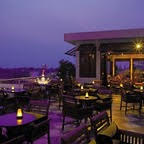https://www.cigaraficionado.com/article/saigon-saigon-bar-vietnam-3853
March 25, 2010
The anticipation of drinking and dining at the legendary rooftop Saigon Saigon Bar in the Caravelle Hotel in Ho Chi Minh City evoked such a rush of emotions that it was difficult to get my head and heart around the paradox and implications of this place historically, and at present, as part of an emerging country with 87 million people. Perhaps it was the coincidental moment of my visit—the 40th anniversary of Woodstock, a 1969 event that gathered hundreds of thousands for three days of peace, love, music and protest. The late 60’s was a turbulent time for me, with Uncle Sam requesting my presence in Vietnam, and here I was after voluntarily traveling 11,000 miles.
During the Vietnam War the Caravelle was an oasis for ABC, CBS, NBC and the professional and social international media hub in Saigon (renamed Ho Chi Minh City in 1976). In the latter days of the American War, as it is still referred to by the Vietnamese, the front line could be seen by journalists from their rooftop bar stools. After a short elevator trip down and a hotel limousine ride to cover an event, correspondents would return for cocktails and discussion at Saigon Saigon before retiring for the night. By the end of the war, the action was so close it could be observed without leaving the bar.
Viewing the city from the rooftop at Saigon Saigon still imparts a stirring impression of the neighborhoods in District 1. It’s no wonder the property was preferred by journalists. Its vantage point allowed surveillance and clear sight lines along streets for some distance. But today, bullet tracers and explosions have been replaced by multitudes of buzzing motorbikes and streaming headlights in Ho Chi Minh City.
I joined Harry, an American journalist now stationed in Ho Chi Minh City, for libation, cigars, food and conversation about the property’s historical significance during the most momentous event of my generation and Vietnam’s continuing evolution from an agrarian society. The 10th floor open air Saigon Saigon features the bar, pleasant window-side table seating, cheery ambiance and an outside terrace.
The cocktail menu has such choices as the Good Morning Vietnam (vodka, Cointreau, cranberry juice, lime juice) and a Saigon Saigon (vodka, lime juice, orange curaçao, midori, cranberry juice), which are served in martini-style glasses. The drink menu offers a broad selection, from malt whiskeys to milk shakes and beers from around the world, including Vietnam’s own 333 and Saigon Special.
Saigon Saigon’s menu is fairly comprehensive and showcases a Vietnamese style of cooking that emphasizes healthier dining: think grilling and steaming instead of frying. On a mid-afternoon visit, with drinks and cigars on our mind, satay, a regional specialty, seemed an ideal fit. Thin strips of chicken, beef or pork are marinated for up to 24 hours in a sweet, sour and salty mixture of lemongrass, onion, garlic, ginger, turmeric, ground coriander seeds, cumin, dark soy sauce, fish sauce, brown sugar and lime juice. Small, wooden skewers hold the meat that is barbecued, grilled or broiled. The traditional dipping peanut sauce for the speared meat is made by blending dry roasted unsalted peanuts, minced garlic cloves, dark soy sauce, sesame oil, brown sugar, fish sauce, tamarind paste or lime juice, cayenne pepper or chili sauce and coconut milk until smooth; it is served warm or at room temperature.
Saigon Saigon is very smoker friendly—smoking is permitted at the bar, at the tables inside, and on the adjacent balcony. We lit up at our table, choosing from a humidor that was sufficiently supplied with Cohiba, Montecristo, Partagas, and Romeo y Julieta Cuban cigars. Along with the food and drink, a Cohiba Siglo II and Montecristo No. 4 lifted the melancholy shroud and greatly enhanced the experience.
Many noted journalists had been here throughout the war. John Steinbeck was at the hotel writing for Newsday during the Tet Offensive in 1968, as was Walter Cronkite. Peter Arnett, who won the 1966 Pulitzer Prize for International Reporting of Vietnam, covered the war from 1962 to 1975 for the Associated Press. He was a regular guest at the hotel and no doubt Saigon Saigon as well. One of the last reporters in Saigon after its capture by the North Vietnamese Army, Arnett watched the final helicopter depart the U.S. Embassy, carrying the last official Americans.
The one-time war sanctuary is a haven of different sorts today, away from the hotel’s bustle and far from the din, maddening crush of humanity and flurry on the streets in this sultry, crowded city.




